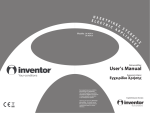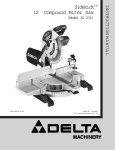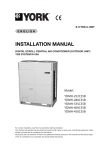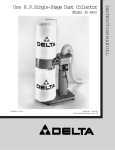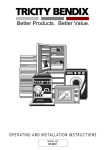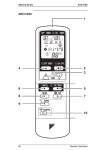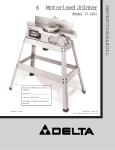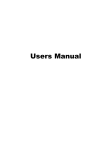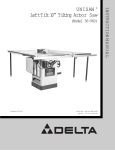Download Delta 50-665 Instruction manual
Transcript
(Model 50-665) Shown with Accessory Dust Collector Drum D ATED 8-8-99 PA RT NO. 1342493 'Delta International Machinery Corp. 1999 INSTRUCTION M A N U A L 11/2 H.P. Dust Collector TABLE OF CONTENTS SAFETY RULES ................................................................................................................................3 IMPORTA N T SAFETY RULES F O R D U S T COLLECTO R S.............................................................4 INTRODUCTION................................................................................................................................4 U N PACKING......................................................................................................................................5 A S S E M B LY........................................................................................................................................6 CONNECTING D U S T COLLECTO R TO P O W E R S O U R C E ..........................................................10 Single Phase Operation..........................................................................................................10 ON/OFF SWITCH ............................................................................................................................10 LOCKING SWITCH IN T H E OFF POSITION ..................................................................................11 MAINTENANCE ...............................................................................................................................11 M O TO R MAINTENANCE.................................................................................................................11 W A R R A N T Y ....................................................................................................................................12 2 IMPORTANT SAFETY RULES W oodworking can be dangerous if safe and proper operating procedures are not followed. As with all machinery, there are certain hazards involved with the operation of the product. Using the machine with respect and caution will considerably lessen the possibility of personal injury. However, if normal safety precautions are overlooked or ignored, personal injury to the operator may result. Safety equipment such as guards, push sticks, hold-downs, featherboards, goggles, dust masks and hearing protection can reduce your potential for injury.But even the best guard won t make up for poor judgment, carelessness or inattention. Always use common sense and exercise caution in the workshop. If a procedure feels dangerous, don t try it. Figure out an alternative procedure that feels safer. REMEMBER: Your personal safety is your responsibility. This machine was designed for certain applications only. Delta Machinery strongly recommends that this machine not be modified and/or used for any application other than that for which it was designed. If you have any questions relative to a particular application, DO N O T use the machine until you have first contacted Delta to determine if it can or should be performed on the product. D E LTA INTERNATIONAL MACHINERY C O R P. M A N A G E R O F TECHNICAL S E RVICES 246 A L P H A DRIVE PITTSBURGH, PENNSYLVANIA 15238 (IN CANADA: 644 IMPERIAL ROAD, GUELPH, ONTARIO N1H 6M7) W ARNING: FAILURE TO F O L L O W THESE RULES M AY RESULT IN SERIOUS P E R S O N A L INJURY 15. MAINTAIN TO O L S IN TO P CONDITION. Keep tools sharp and clean for best and safest performance. Follow instructions for lubricating and changing accessories. 1. F O R Y O U R O W N S A F E T Y, READ INSTRUCTION M A N U A L B E F O R E O P E R ATING T H E TO O L. Learn the tool s application and limitations as well as the specific hazards peculiar to it. 16. DISCONNECT TO O L S before servicing and when changing accessories such as blades, bits, cutters, etc. 2. K E E P G U A R D S IN PLACE and in working order. 17. U S E R E C O M M E N D E D ACCESSORIES. The use of accessories and attachments not recommended by Delta may cause hazards or risk of injury to persons. 3. A LW AY S W E A R E Y E PROTECTION. 4. R E M O V E ADJUSTING KEYS A N D W R E N C H E S. Form habit of checking to see that keys and adjusting wrenches are removed from tool before turning it on. 18. R E D U C E T H E RISK O F UNINTENTIONAL S TA R TING. Make sure switch is in OFF position before plugging in power cord. 5. K E E P W O R K A R E A C L E A N. Cluttered areas and benches invite accidents. 19. N E V E R STA N D O N TO O L. Serious injury could occur if the tool is tipped or if the cutting tool is accidentally contacted. 6. DON T U S E IN D A N G E R O U S ENVIRONMENT. Don t use power tools in damp or wet locations, or expose them to rain. Keep work area well-lighted. 9. DON T FORCE TO O L. It will do the job better and be safer at the rate for which it was designed. 20. C H E C K D A M A G E D PA R T S. Before further use of the tool, a guard or other part that is damaged should be carefully checked to ensure that it will operate properly and perform its intended function check for alignment of moving parts, binding of moving parts, breakage of parts, mounting, and any other conditions that may affect its operation. A guard or other part that is damaged should be properly repaired or replaced. 10. U S E RIGHT TO O L. Don t force tool or attachment to do a job for which it was not designed. 21. DIRECTION O F FEED.Feed work into a blade or cutter against the direction of rotation of the blade or cutter only. 11. W E A R P R O P E R A P PA R E L. No loose clothing, gloves, neckties, rings, bracelets, or other jewelry to get caught in moving parts. Nonslip footwear is recommended. Wear protective hair covering to contain long hair. 22. N E V E R L E AV E TO O L RUNNING UNATTENDED. TURN P O W E R O F F. Don t leave tool until it comes to a complete stop. 7. K E E P CHILDREN A N D VISITO R S AW AY. All children and visitors should be kept a safe distance from work area. 8. M A K E W O R K S H O P CHILDPROOF with padlocks, master switches, or by removing starter keys. 23. DRUGS, ALCOHOL, MEDICATION. Do not operate tool while under the influence of drugs, alcohol or any medication. 12. A LW AY S U S E SAFETY GLASSES.W ear safety glasses. Everyday eyeglasses only have impact resistant lenses; they are not safety glasses. Also use face or dust mask if cutting operation is dusty. 24. M A K E S U R E TO O L IS DISCONNECTED FROM POWER SUPPLY while motor is being mounted, connected or reconnected. 13. S E C U R E W O R K. Use clamps or a vise to hold work when practical. It s safer than using your hand and frees both hands to operate tool. 25. W ARNING: The dust generated by certain woods and wood products can be injurious to your health. Always operate machinery in well ventilated areas and provide for proper dust removal. Use wood dust collection systems whenever possible. 14. DON T O V E R R E A C H. Keep proper footing and balance at all times. 3 IMPORTA N T SAFETY RULES F O R D U S T COLLECTO R S 0. D O N O T pull the dust collector by the power cord. W ARNING: Basic precautions should 1NEVER allow the power cord to come in contact with always be followed when using your dust collector. To reduce the risk of injury, electrical shock or fire, comply with the safety rules listed below: sharp edges, hot surfaces, oil or grease. 11. D O N O T unplug the dust collector by pulling on the power cord. A LW AY S grasp the plug, not the cord. 1. R E A D and understand the instruction manual before operating the dust collector. 12. D O N O T handle the plug or dust collector with wet hands. 2. D O N O T leave the dust collector plugged into the electrical outlet. Unplug dust collector from the outlet when not in use and before servicing, changing bags, unclogging and cleaning. 13. REPLACE a damaged cord immediately.D O N O T use a damaged cord or plug. If the dust collector is not operating properly, or has been damaged, left outdoors or has been in contact with water, return it to an Authorized Service Center for service. 3. A LW AY S turn the power switch OFF before unplugging the dust collector. 14. D O N O T use the dust collector as a toy. D O N O T use near or around children. 4. W ARNING: TO R E D U C E T H E RISK O F ELECTRICAL S H O C K, do not use on wet surfaces. Do not expose to rain. Store indoors. 15. D O N O T insert fingers or foreign objects into the dust intake port. Keep hair, loose clothing, fingers, and all body parts away from openings and moving parts of the dust collector. 5. F O L L O W all electrical and safety codes, including the National Electric Code (NEC) and the Occupational Safety and Health Regulations (OSHA). All electrical connections and wiring should be made by qualified personnel only. 16. D O N O T use the dust collector without the dust collection bag in place and properly secured. 6. D O N O T use the dust collector to pick up flammable or combustible liquids, such as gasoline. N E V E R use the dust collector near any flammable or combustible liquids. 17. A LW AY S use safety gates to cover dust ports when the dust collector is not in use or mounted to a supporting surface for storage. 7. U S E the dust collector to pick up wood materials only. D O N O T use the dust collector to pick up metal shavings, metal dust, or parts. 18. PERIODICALLY INSPECT dust bag for any cuts, rips or tears. NEVER operate the dust collector with a damaged bag or vacuum hose. 8. NEVER use the dust collector to dissipate fumes or smoke. N E V E R pick up anything that is burning or smoking, such as cigarettes, matches or hot ashes. 19. The dust collector is designed for home use or light commercial duty O N LY! 20. C O N N E C T dust collector to a properly grounded outlet only. See grounding instructions. 9. U S E only as described in this manual. U S E only accessories recommended by Delta. S AV E THESE INSTRUCTIONS INTRODUCTION Dust Collectors work by moving large volumes of air at lower suction pressures than vacuum cleaners. Delta dust collectors are not designed to be used as high-suction cleaners; however, they are designed to help maintain clean, safe conditions around dust-creating machines in workshops and factories. The flexible hose furnished with each unit can be connected directly into the woodworking machine. 4 U N PACKING Carefully unpack the dust collector from the shipping container and check for any damaged or missing parts. Fig. 2, illustrates the components of the dust collector. 2 3 1 4 10 5 8 13 12 6 9 7 11 14 15 Fig. 2 1. Blower and Motor Assembly 2. Vacuum Hose 10. Hardware for Mounting Cylinder to Cover, Includes: 1/4-20 x 5/8 Hex Head Screws, Flat Washers, and Locknuts (4 ea.) 3. Cylinder 11. Reducer 4. Dust Bag Elbow 12. Inlet Elbows (2) 5. Hose Clamps (2) 13. Gasket Material 6. Dust Bag 14. Gaskets (2) 7. Dust Bag Clamp 15. Hardware for Mounting Cover to Fan and Blower Assembly, Includes: 5/16-18 x 1-1/4 Flat Washers, Lockwashers, and Locknuts (4 ea.) 8. Hardware for Mounting Inlet Elbows, Includes: 3/8-16 x 1-1/4 Hex Head Screws (2), Flat Washers (4), Lockwashers (2), and Locknuts * 9. Pan Head Screws 5 Safety Grid (not shown) A S S E M B LY 1. Place gasket (A) Fig. 3, on bottom of motor and blower assembly (B). Align four holes in gasket with holes in motor and blower assembly and assemble cover (C) Fig. 3, to gasket and motor and blower assembly with four hex head screws, flat washers, lockwashers, and locknuts (D). B C A D Fig. 3 2. Fig. 4, illustrates the cover (C) assembled to the underside of motor and blower assembly (B). 3. Peel the adhesive paper (E) Fig. 5, from the back of the gasket material (F) and press the gasket material around the underside of the dust collector cover (C). Cut off any excess gasket material. C B 4. Carefully turn the assembly over. Place gasket (G) Fig. 6, over two holes in cover (C) and secure upper inlet elbow (H) to cover with two 3/8-16 x 1-1/4 hex head screws and flat washers (J), as shown in Fig. 7. Fig. 4 C F C G H E J Fig. 5 6 J J Fig. 6 J 5. Position the remaining inlet elbow (K) Fig. 8, at the underside of dust collector lid (C) as shown. Align the mounting holes in inlet elbows (K) Fig. 8, with screws (J) assembled to upper inlet elbow (H) shown in Fig. 7, STEP 4, and fasten the upper and lower inlet elbows to the cover with remaining two flat washers, lockwashers, and locknuts (J) Figs. 7 and 8. Fig. 7 H C J K Fig. 8 6. Place the sheet metal cylinder (L) Fig. 9, onto the underside of the cover.Align four holes in cylinder bracket, three of which are shown at (M), with four holes (N) in the underside of cover and fasten with four 1/4-20 x 5/8 hex head screws, lockwashers, and locknuts (P) Fig. 10. NOTE: Assemble screws from the top of the lid downward. CAUTION: Sheet metal cylinder (L) is extremely sharp; use protective gloves when assembling the sheet metal to the underside of the lid. N L M 7. Assemble safety grid (V) Fig. 11, over metal cylinder (L) and fasten grid to cylinder with three pan head screws (W) as shown in Fig. 12. M N Fig. 9 P L V L P Fig. 10 Fig. 11 7 W V L CAUTION: Never remove safety grid for any reason except to perform maintenance procedures. There is a high speed blower wheel inside the blower housing that can amputate fingers, grab loose clothing or neckties. Make certain the dust collector is disconnected from the power source before performing any maintenance procedures. W Fig. 12 8. Place the entire blower and motor assembly (C) Fig. 13, into collection drum (R) (not supplied). C R Fig. 13 T V P W ARNING: The dust collector has a safety guard (P) Fig. 14, at the blower housing of the dust collector, which contains a high speed radial blade that can amputate fingers, grab loose clothing and neckties, or propel dust at high velocities. This guard is for your safety. DO N O T R E M O V E THIS G U A R D F O R A N Y REASON! Y Fig. 14 9. Place the bag elbow (V) Fig. 14, over the dust discharge port (T). Align three holes in bag elbow with three mounting holes in dust discharge port (T) and fasten bag elbow (V) to discharge port (T) with three sheet metal screws (Y) Figs. 14 and 15, two of which are shown. Y Fig. 15 8 10. Insert the bag clamp (Z) Fig. 16, through the loops of the dust bag (A). Z A Fig. 16 11. Clamp dust bag (A) Fig. 17, to bag elbow (V) as shown by fastening bag clamp (Z). V Z A Fig. 17 12. Assemble reducer (B) Fig. 18, over the end of inlet elbow (H). H B Fig. 18 13. Assemble hose clamp (C) Fig. 19, over one end of hose (D). Assemble hose (D) onto reducer (B) and tighten clamp (C) to hold hose onto reducer. B C D Fig. 19 9 CONNECTING DUST COLLECTOR TO POWER SOURCE Before connecting your dust collector to an electrical power system, be sure the motor rating agrees with the electrical system it is to be connected to. SINGLE P H A S E O P E R ATION If the motor on your dust collector is wired for 115 Volt, single phase, the power cord is equipped with a plug that has two flat, parallel current-carrying prongs, and one longer round or U shaped ground prong which requires a mating 3-conductor grounded type receptacle, as shown in Fig. 20. If the motor on your dust collector is wired for 230 Volt, single phase, the power cord is equipped with a plug that has two flat, current-carrying prongs in tandem, and one round or U shaped longer ground prong. This is used only with the proper mating 3-conductor grounding type receptacle, as shown in Fig. 21. Fig. 20 When the three-prong plug on your dust collector is plugged into a grounded 3-conductor receptacle, the long ground prong on the plug contacts first so the machine is properly grounded before electricity reaches it. CAUTION: IN ALL CASES, MAKE C E R TAIN T H E RECEPTACLE IN QUESTION IS PROPERLY GROUNDED. IF Y O U A R E N O T S U R E,H AV E A CERTIFIED E L E CTRICIAN CHECK THE RECEPTACLE. Fig. 21 ON/OFF SWITCH The ON/OFF switch is conveniently located on the side of the motor.To turn the dust collector ON push the switch (A) Fig. 22, upward to the ON position. To turn the dust collector OFF , push the switch down to the OFF position. A Fig. 22 10 A B Fig. 23 LOCKING SWITCH IN THE OFF POSITION W e suggest when the dust collector is not in use that the ON/OFF switch be locked in the OFF position. This can be done by grasping the switch toggle (B) Fig. 23, and pulling it out of the switch (A) as shown. W ith the switch toggle (B) removed, the switch will not operate. However, should the switch toggle (B) Fig. 23, be removed while the machine is running, it can be turned OFF, but cannot be restarted without inserting the switch toggle (B) back into the switch. Fig. 24 MAINTENANCE NOTE: M A K E C E R TAIN THE MACHINE IS DISCONNECTED F R O M THE P O W E R SOURCE. The dust bag furnished with the dust collector features a zippered opening for fast and easy dust removal, as shown in Fig. 24. IMPORTA N T:The operator performing this cleaning function should always wear eye protective goggles. The aluminum blower impeller and all sheet metal fittings are maintenance-free and should not require any maintenance during the life of the unit. M O TO R MAINTENANCE Removing dust and dirt: Blow off the motor with low pressure air to remove dust or dirt. Air pressure above 50 P.S.I. should not be used as high pressure may damage insulation. IMPORTA N T:The operator performing this cleaning function should always wear eye protective goggles. Dust can cause excessive insulation temperatures. 11 Delta Building Trades and Home Shop Machinery Two Year Limited Warranty Delta will repair or replace, at its expense and at its option, any Delta machine, machine part, or machine accessory which in normal use has proven to be defective in workmanship or material, provided that the customer returns the product prepaid to a Delta factory service center or authorized service station with proof of purchase of the product within two years and provides Delta with reasonable opportunity to verify the alleged defect by inspection. Delta may require that electric motors be returned prepaid to a motor manufacturer s authorized station for inspection and repair or replacement. Delta will not be responsible for any asserted defect which has resulted from normal wear, misuse, abuse or repair or alteration made or specifically authorized by anyone other than an authorized Delta service facility or representative. Under no circumstances will Delta be liable for incidental or consequential damages resulting from defective products. This warranty is Delta s sole warranty and sets forth the customer s exclusive remedy, with respect to defective products; all other warranties, express or implied, whether of merchantability, fitness for purpose, or otherwise, are expressly disclaimed by Delta.












